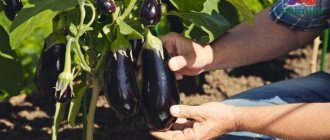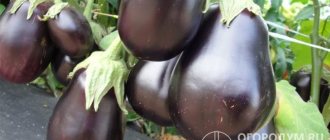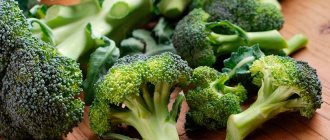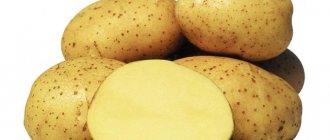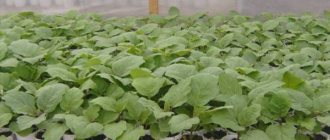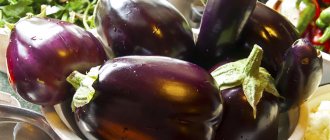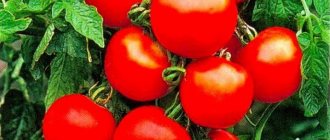Description of the eggplant variety Vera
The fruits are pear-shaped, elongated 15-20 cm and about 200 g
The Vera eggplant variety is early; it takes an average of 115 days for the first fruits to fully ripen. The bushes grow up to 75 cm or a maximum of 100 cm in greenhouse conditions. The leaves are medium-sized, green with a purple tint. There are notches along the edges of the sheet plate. The bushes are almost thornless.
The fruits are pear-shaped, elongated 15-20 cm and about 200 g. The color is dark purple. The peel is smooth, glossy, thin. The pulp is white, medium density, without voids. The taste is without bitterness, pleasant. The Vera variety of eggplant can be stewed, boiled, fried, baked. The harvest that is not consumed in the summer can be frozen or dried and used in the winter to prepare a variety of dishes.
Advantages and disadvantages of the variety
The Vera variety is ideal for gardeners from regions with unpredictable climatic conditions. An early ripening vegetable will not keep you waiting long and will delight you with the first harvest in 2.5 months.
The commercial qualities of the variety are excellent; the purple glossy color looks appetizing and attractive. The taste is without bitterness, pleasant. The vegetable is universal and goes well with fish, meat, and other vegetables. Suitable for canning and pickling.
The variety has only one drawback: it shows average yield. Many other early ripening varieties have a richer harvest.
Characteristics of eggplant Vera
Also check out these articles
- Raspberry Pride of Russia
- Wheat bran
- Pavlovsk lemon - growing features and care
- Beneficial properties of goat milk
Cross-sectional photo of Vera eggplants
The Vera variety of eggplant has its own special qualities that distinguish it from other varieties and hybrids.
- Early variety. Technical ripeness of fruits is observed in August or early September.
- The variety is suitable for growing in greenhouses and open ground.
- Productivity is average but stable. From a bush you get approximately 500-1000 g of fruit, and from a square meter, respectively, about 4 kg (depending on the density of plantings).
Important!
Dense planting does not ensure high yields. On the contrary, densely planted bushes have no way to develop and produce much less harvest.
- An adult plant is resistant to cold weather.
- Commercial quality 90-100%.
- Transportability at a high level.
Additional feeding
Like the human body, the fruits of the Vera eggplant also need not only drink, but also nutrition. Often the reason for a failed harvest is a lack of nutrients in the plant. At the same time, some summer residents do not pay enough attention to this point. Plant nutrition is applied in small quantities or not at all.
However, the application of fertilizers is fraught with nuances. If the plant does not receive enough nutrients, then the fruits are small in size (smaller than average) and there are very few of them. If Vera eggplants are given too much fertilizer, the result can be quite powerful bushes, but practically without fruits. In addition, plants do not tolerate excessive nutrition and low temperature conditions, which leads to the formation of nitrates in eggplant fruits. And this, as we know, does not benefit either plants or people. In other words, everything needs moderation.
Typically, during the entire period, from planting the bushes to the formation of Vera eggplant fruits, it is necessary to apply fertilizer 3 to 5 times. In some cases this should be done more often.
Impact of nutritional deficiencies
Every summer resident needs to know the consequences of an insufficient amount of natural elements:
- Nitrogen. With its obvious deficiency, plants experience a decrease in leaves. Moreover, they acquire a pale green tint, and then most of them fall off. Eggplant fruits may ripen, but they are very small in size. The situation can be corrected by adding ammonium nitrate and bird droppings. The main thing is not to overdo it.
- Phosphorus. This element is simply necessary for the normal development of the root system. Its deficiency is indicated by the characteristic purple-blue color of the plant’s leaves. Only here it is worth knowing that it is necessary to maintain a certain soil temperature, which should be more than 15 degrees. When it decreases, phosphorus will not be absorbed by plants.
- Potassium. Another important element of the periodic table, which is necessary for Vera eggplants at the beginning of the fruiting period. Its deficiency can occur if plants are grown in peat or sandy soil. This is especially acute in dry weather conditions. A characteristic sign may be yellowing of the leaves of the plant, the edges of which begin to dry out. At the same time, the Vera eggplant fruits themselves begin to become stained. Timely application of potassium magnesia or ash will avoid troubles and protect the fruits. Potassium sulfate can give a good effect after the plant blooms.
- Calcium. Without this element, it is impossible to achieve a high yield when growing Vera eggplants in soil with a high level of acidity. If there is not enough of it, the plant root system slows down its growth, the buds die, and the contours of the leaves are “decorated” with white stripes. To compensate for the loss of fruits, you need to apply fertilizer based on calcium nitrate or spray the plants using calcium chloride.
- Bor. A deficiency of this element is often found in wetlands. The flowers of the plant lose their ability to pollinate and after a while begin to fall off, which leads to a significant reduction in fruits. Timely application of borax or spraying with boric acid will help correct the situation.
- Magnesium. When a plant lacks this element, colorless veins can be seen on the leaves. The recommended amount of potassium magnesium or ash will help prevent this.
- Manganese. If the soil contains alkali and there is a lot of humus in it, then the lack of the element is a characteristic feature of such land. On the leaves of the plant you can see interesting patterns of yellow spots. Manganese sulfate or spraying with it only in the form of a solution will make up for losses.
Sowing seedlings
Photo of growing seedlings in a greenhouse under film
You can sow Vera eggplant seeds directly into open ground only in the southern regions. But even there, gardeners often use seedlings to get the harvest much earlier. Seeds for seedlings are sown from the end of February until the first half of March. Sowing is carried out in a container with a diameter of about 8 cm. Trenches are made, seeds are sown in them, sprinkled with earth, sprinkled with water from a spray bottle on top and covered with film.
Important!
If the seeds are sown directly into the garden bed, then this should be done in April or May, when a stable temperature has established and the spring cold has passed.
The seeds will germinate in about 5-20 days, depending on conditions, soil, temperature, lighting. The type of seed is also important. If you buy them at the market (by weight), then the chance of friendly shoots is minimal, but if you buy them in a store, in bags, and even choose a good manufacturer, then shoots will appear earlier. After emergence of shoots, the film is removed. Before planting in open ground, approximately 2 months should pass from the day the seedlings appeared. During this time, the sprouts will become stronger and will be resistant to weather changes and diseases.
Photo of planting eggplant Vera in open ground
Features of cultivation
The time for planting seeds depends on the region. In places where the climate is warm, they can be planted immediately in open ground in mid-April or early May. For cool areas, seedlings are grown first. In this case, the seeds are sown in February or March.
Before planting, the seeds need to be prepared. This is done like this:
- Soak in water for 25 - 30 minutes, remove those that float.
- The seeds that have fallen to the bottom are dried and heated at a temperature of 50 -55 degrees. Can be heated on a heating device.
- Disinfect with a one percent solution of potassium permanganate a few days before planting.
Attention. Aloe juice can be used as a stimulant and disinfectant. For seed treatment, juice is obtained from aloe leaves that are at least 3 years old. The seeds are kept in the solution for 24 hours.
For seedlings, each seed is planted in separate containers to avoid picking, since eggplants have a very delicate root system. The soil should consist of a mixture of:
- peat;
- humus;
- sand.
You can buy ready-made. The seeds are deepened into the soil half a centimeter, sprinkled with sand and covered with film.
Keep the temperature at +24 .. +26 degrees. Sprouts should appear in 10 -15 days. Then it is reduced to +16..+18 to allow the plants to get stronger. After 5 days, it is again increased to +25 degrees during the day and +15 .. +17 at night.
For full development, plants need to be illuminated with phytolamps, but ordinary fluorescent lamps are also suitable.
Seedlings are fed after two leaves appear. To do this, use a solution based on potassium, phosphorus and nitrogen. The second time feeding is carried out after 2 weeks.
Before planting in open ground, plants are hardened off by taking them outside for 2-3 hours, and then the time is gradually increased.
2 months after the germination of 5-6 leaves, the eggplant seedlings are ready to be transplanted into the garden. It is better to plant in the evening. Most often this happens in May or June. The soil needs to be enriched with organic fertilizers.
For planting, make a hole 10-15 cm deep, pouring a little water into it. Plants are planted every 30–35 cm. 50–70 cm are left between rows. The top of the hole is mulched so that moisture does not evaporate.
It is better to plant eggplants in the places where they grew before:
- legumes;
- zucchini;
- carrot;
- onion.
Planting eggplant
We recommend reading our other articles
- When do guinea fowls start laying eggs?
- Rabbits of the White Giant breed
- How to treat turkey histomoniasis and preventive measures
- Why do raspberry leaves turn yellow?
It is advisable to plant Vera eggplants in fertile, light soil rich in organic matter. Therefore, starting in the fall, the area allocated for the crop is fertilized with manure, compost or humus. In the spring, the bed can be dug up again, loosened and covered with polyethylene so that the earth warms up as quickly as possible. The place should be illuminated and protected from strong winds.
Planting seedlings in greenhouses or open ground is carried out in May, when the ground has warmed up well to +14 degrees and the threat of return frosts has disappeared. For the sprouts, make holes at a distance of 30-35 cm, with 60-65 cm of free space between the rows.
There should be 60-65 cm of free space between the rows
Diseases and pests
The following pests can attack plant beds:
- Spider mite. It loves moisture and often appears in greenhouses. Spraying with whey helps get rid of it. The method is harmless to humans.
- Mole cricket and wireworm. To prevent the appearance of such pests, the soil before planting is treated with a solution of copper sulfate or watered with Bordeaux mixture.
- Colorado beetle. They are usually collected by hand. To deter them, plant basil or marigolds nearby.
Diseases:
- Blackleg and late blight most often affect eggplants. To combat the fungus, use the drug "Oxychom" or wood ash.
- Mosaic. It appears as yellow patterns on the leaves. The drug “Fitosporin” is suitable for treatment.
Plant care
For proper development, bushes need not only proper planting or a good location. Care throughout growth also plays a significant role.
- Vera eggplants are watered regularly, right at the root, so that the earthen lump does not dry out. To do this, use warm water, which can be left in the sun. Before flowering, watering is carried out approximately once a week at the rate of 12 liters of water per square of planting. After flowering begins, watering is carried out every 3-4 days.
- During the entire growing season, the bushes are fed 3-5 times. Fertilizers for Vera eggplants should include nitrogen, potassium, calcium, magnesium, phosphorus, boron and manganese. But depending on the time of feeding, the concentration of certain substances will be different. So, at the beginning of the growing season you need more nitrogen, and at the end - phosphorus and potassium.
Vera eggplants are watered regularly, right at the root.
Interesting!
The optimal temperature for the development and fruiting of eggplants is +20...25 degrees. Prolonged heat (above +30 degrees) or prolonged cold spells slow down the growth and inhibit the development of the Vera eggplant variety. At this time, flowers and even ovaries on bushes may fall off.
- It is not necessary to tie up the plants, because they grow short, however, during fruiting, eggplants can pull branches to the ground!
- Form a bush with 3-5 stems. Up to 10 ovaries are usually left on each plant so that the load is not very heavy.
- All the stepsons that appear (and there are quite a few of them) need to be removed, just like the leaves growing below the first branch.
- Eggplants can suffer from blackleg and late blight. For prevention, plants and soil can be treated with special fungicides. But if the bush still gets sick, you need to remove it from the garden bed as quickly as possible so that the disease does not spread to other plants.
- Pests rarely attack the Vera variety. Most often you can find the Colorado potato beetle on leaves. It is worth using insecticides or simply collecting it by hand. Many gardeners plant marigolds or basil nearby; they repel this pest with their smell.
Transplantation and care in the greenhouse
If the greenhouse is not heated, then it is better to plant in early June so that the plants take root better. The soil must be fertilized beforehand. Manure or compost will do, but you can also add peat, ash or sawdust.
Plants are placed at a distance of 40–45 cm. One square meter yields 4–5 bushes. After planting, compact the soil and water it with water at room temperature.
In the first 10 days, eggplants are watered every day. Then watering is reduced to once a week, but after the ovaries appear, this is done twice every 7 days. In hot weather even more often.
In addition to watering, plants need fertilizing and loosening the soil around the bushes. You need to feed 3-5 times during the summer. This matter has its own characteristics. It is necessary to alternate mineral and organic fertilizers:
- The first time they are fed 15-20 days after planting.
- Before fruit setting, complex mineral fertilizers are used.
- After the ovary appears, it is better to feed it with nitrogen-phosphorus supplements.
You can also fertilize with organic fertilizer in between.
It is important to maintain a constant temperature in the greenhouse within +26...+28 degrees. At higher rates, the plants will die. Therefore, it is advisable to place a thermometer there. In very hot weather, ventilation is necessary. But at night everything should be closed.
Attention. If the air outside is very hot, you can water the plantings with cool water to cool the soil.
It is advisable to tie up grown bushes, since they grow taller in a greenhouse than in open ground. Leave no more than 5-7 fruits on one plant.
Harvest and storage
Photo of Vera eggplant harvest
Vera eggplants are harvested immediately after they are ripe. There is no point in delaying this matter. Once overripe, they become too large, the skin may become rough, and the taste is no longer as mild. Cut the eggplants together with the stalk 4-5 cm long.
After harvesting, the Vera variety eggplants are stored. In a cool place they lie without loss of appearance or taste for up to 40 days. Ripe fruits are used to prepare a wide variety of culinary dishes.
How are they stored and where are they used?
The collected fruits are wiped with a dry cloth and placed in wooden boxes. Store in a cool place for no more than 40 days. Then the taste is lost. We wrote about how to store eggplants in the refrigerator in this article.
- The vegetable makes excellent savory snacks, salads and side dishes.
- It is also suitable for stuffing with meat or poultry.
Important. Eggplant has low calorie content, ideal for those watching their figure. - It is easy to make soup - puree, pate or caviar.
- In addition, the fruit is used as a face mask. It is crushed, applied to the face and kept for 20 minutes. This stimulates metabolic processes in the skin.
Read about the chemical composition of eggplant, as well as its benefits and harms for the human body, here.
The beautiful purple color and pleasant taste of eggplants attract many gardeners. The Vera variety is not very productive, but it is suitable for growing in cold areas. Getting a harvest will not be difficult if you follow the watering and fertilizing regime.
You will find the characteristics and features of growing other varieties of eggplant - Japanese Dwarf, Market King f1, Bibo, Universal 6, Black Beauty, Diamond, Valentina f1, King of the North f1, as well as white and round varieties of this vegetable - in our separate articles.
Reviews of eggplant Vera
Photo of eggplant rolls Vera
It cannot be said that absolutely everyone likes the Vera eggplant variety. Due to the demands on fertilizing, many people refuse it, and its low yield does not allow it to be grown on an industrial scale, but reviews about the variety are mostly positive.
- Maria Zabotina : “I really like the Vera variety because of its lack of bitterness. Before cooking, you don’t need to soak the eggplants or go into other tricks so that the bitterness goes away, and I reduced the cooking time to a minimum in order to preserve all the beneficial substances in the vegetable. For an eggplant lover like me, this variety is a real gift.”
- Andrey Fadeev : “I have been growing this small, one might say compact plant for more than 3 years in greenhouses. The yield there is higher than in open ground, and the harvest can be obtained earlier. True, you have to fertilize often - sometimes the leaves turn yellow, sometimes they fade, sometimes the bush starts to droop towards the ground. But after applying fertilizing, the problems disappeared.”
- Olga Shevchenko : “The harvest of eggplants of the Vera variety is small, but of high quality. From each bush I collect on average up to 5 fruits when grown in open ground. This is not very much, there are also more productive varieties, but because of the taste and undemanding cultivation, I choose this particular variety.”
Planting seedlings in open ground
Eggplants should be planted in the ground in a permanent place after the weather becomes warm outside. Usually this is mid-May. In the northern regions, the landing dates are shifted by several weeks, closer to June. In the southern regions, on the contrary, seedlings are planted in early spring:
- Before planting, the soil is dug up, weeds are removed and manure is added.
- Make beds and dig holes 30 cm deep.
- The distance between the holes is left 50-60 cm.
- Place the seedling in the hole and bury it with soil.
- Lightly compact the soil near the base of the stem.
At the end of replanting, irrigate the soil with warm water. At night, the beds are covered with a warm cloth.
Advantages and disadvantages
This variety has many advantages, and this is noted by many gardeners. However, Eggplant Vera has its own disadvantages that need to be studied first.
Main advantages:
- good yield;
- the fruits have a good presentation;
- versatility of use;
- there is no bitterness;
- early start of ripening;
- small number;
- resistance to temperature fluctuations;
- It does not require special care;
- Suitable for transportation and long-term storage.
Negative sides:
- spiked cups;
- average yield;
- treatment for diseases and pests is required.


